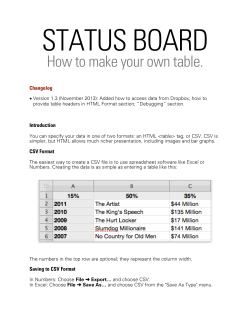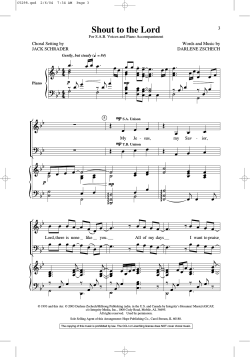
Planning a home page Adobe Dreamweaver CS4
Adobe Dreamweaver CS4 Planning a home page The home page wireframe includes a design layout (graphics, text, and site naviga on scheme) to make crea ng the home page easier. Use the following guidelines to help you create the wireframe of your home page by using Adobe Fireworks. Graphics Draw rectangles on the page to indicate the size and placement of graphics. Label these rectangles with the filenames of the graphics they represent. • • What graphics will you include on the home page? Where will you place the graphics on the page? Text Draw rectangles on the page to indicate the text placement. Label these rectangles with content descrip ons. • • What text will you include on the home page? Where will you place text on the page? Naviga on Draw a rectangle to indicate the placement of the links to other pages. Label this rectangle with the names of the other pages. (You will build graphical bu ons for these links later in this course.) • According to your flowchart, the home page directly links to what pages (what are the menu items)? • Where will you place these links on your home page? Color Fill in the background of the wireframe with your desired color and create sets of sample text that show the different text colors you plan to use on your home page. How to lay out a web page with CSS You can use table design features in Adobe Dreamweaver CS4 to create a simple page layout. However, a more powerful technique is to use Cascading Style Sheets (CSS). The basic building block of CSS layout is the div tag—an HTML tag that in most cases acts as a rectangular container for text, images, and other page elements. When you create a CSS layout, you place div tags (or divs) on the page, add content to them, and posi on them in various places. Unlike table cells, which are restricted to exis ng somewhere within the rows and columns of a table, divs can appear anywhere on a web page. You can posi on divs absolutely (by specifying x- and y-coordinates), or rela vely (by specifying their distance from other page elements). In Dreamweaver, you can quickly and easily place an AP div (short for absolutely posi oned div tags). These elements provide great control over the page layout, reduce the amount of code you need, and enable you to format layout blocks with margins, borders, and colors. In addi on, people using screen readers to view web pages have a much Educa onal Technology Consul ng 50 Adobe Dreamweaver CS4 easier me browsing pages built with CSS because the code is simpler and shorter. The limita on of an AP div, however, is that since it is absolutely posi oned, its posi on never adjusts on the page to accommodate to the size of the browser window. You will learn more about CSS in later units. Crea ng a new page Activity 1. Start Dreamweaver. 2. Make sure the Files panel is visible (Figure 37). In Windows, it is docked at the right side of the screen. If the Files panel is not open, select Window > Files. Site menu Figure 37 Files panel 3. Make sure your por olio site is selected. If it is not, click the Site pop-up menu and select your por olio site. 4. Select File > New. The New Document dialog box opens (Figure 38). Figure 38 The New Document dialog box 5. With the Blank Page category selected under Page Type, click HTML. Educa onal Technology Consul ng 51 Adobe Dreamweaver CS4 6. Click Create. A new un tled HTML document opens. 7. To save the un tled document as your home page, select File > Save As. The Save As dialog box opens to the root folder of your por olio site automa cally. 8. Name the new page index.html and click Save. The new file, index.html, is added to the root folder in the Files panel (Figure 39). Figure 39 Files panel showing index.html Inser ng a div tag Activity 1. Select the Layout category in the Insert bar. Make sure the Standard mode bu on is selected (Figure 40). 2. Click the Draw AP Div bu on (Figure 40). The mouse pointer changes to a cross when you move it over the page. Draw AP Div bu on Figure 40 Insert bar, Layout category 3. Select one of the page areas on your storyboard. To create the div that will define this area on your page, drag a rectangle in the Dreamweaver document. When the rectangle matches the page area’s size on your storyboard, release the mouse bu on. 4. Click the border of the div to select it. Handles appear along the border (Figure 41) and the div proper es appear in the Property inspector. Educa onal Technology Consul ng 52 Adobe Dreamweaver CS4 Figure 41 Div inserted and selected 4. Make sure the Property inspector is open (Figure 42). In Windows, it is docked at the bo om of the screen. If the Property inspector is not open, select Window > Proper es. 5. Click in the CCS-P Element ID box (Figure 42) and enter a name for the div. Choose a unique name that will help you remember the div’s contents, such as header or naviga on. CSS-P Element ID box Figure 42 CSS-P Element ID Property inspector Note: “CSS-P” is a commonly accepted abbrevia on for “CSS Posi oning”. 6. Click the Bg color box and select a color in the color picker. The div changes to the selected color. 7. Open the AP Elements panel (Window > AP Elements). You’ll see that Dreamweaver has added the new div to the list of AP Elements. 8. Click once outside the new div to deselect it. A thin black line appears around the div. This line does not appear in a browser. If you do not see the line, select View > Visual Aids > CSS Layout Outlines. 9. Con nue adding divs for all the sec ons on your storyboard. You can place divs directly alongside one another (Figure 43). Educa onal Technology Consul ng 53 Adobe Dreamweaver CS4 Figure 43 Mul ple divs on page AP Elements panel 10. Save your page. Resizing divs You can resize an individual div or simultaneously resize mul ple divs to make them the same width and height. Note: If the Prevent Overlaps op on is selected in the AP Elements panel, you will not be able to resize a div so it overlaps with another div. Activity 1. Select a div by clicking its border or by clicking the div’s name in the AP Elements panel. 2. Do one of the following to resize the div: • • To resize by dragging, drag any of the div’s resize handles (Figure 44). To resize one pixel at a me, hold down Control (Windows) or Op on (Mac OS) while pressing an arrow key. Note: The arrow keys move the right and bo om borders of the div; you can’t resize the top and le borders with this technique. • In the Property inspector, type values for width (W) and height (H). Draw AP Div bu on Figure 44 Resize by dragging Educa onal Technology Consul ng 54 Adobe Dreamweaver CS4 Moving divs You can move divs in Design view in much the same way you move objects in most basic graphics applica ons. You can move divs in Design view in much the same way you move objects in most basic graphics applica ons. To move one or more selected divs: Activity 1. Select one or more divs. 2. Do one of the following: • To move by dragging, drag the div’s selec on handle (Figure 45). • To move one pixel at a me, use the arrow keys. Note: If the Prevent Overlaps op on is selected in the AP Elements panel, you will not be able to move a div so that it overlaps another div. Selec on handle Figure 45 Moving a div Adding content to divs You can add images, text, and other content (such as Flash movies) to your divs just as you would elsewhere in a web page. Activity 1. To insert an image in a div, click in the div and select Insert > Image on the menu bar. Note: Make sure the div is sized large enough to hold the image or other content. If the div is sized smaller than the image, the div may not display correctly in all browsers. 2. In the Select Image Source dialog box, locate and select an image to insert (such as your page banner). Then click OK (Windows) or Choose (Mac OS). The image appears on the div (Figure 46). Educa onal Technology Consul ng 55 Adobe Dreamweaver CS4 Figure 46 Div with image added 3. To format the image in the div, select the image and select forma ng elements in the Property inspector. 4. To add text to a div, click in the div and type text or paste text copied from another document. Previewing a page You can add images, text, and other content (such as Flash movies) to your divs just as you would elsewhere in a web page. To preview the page in a browser (Figure 47), select File > Preview In Browser and then select a browser from the submenu (or press F12). Note: It is important to preview in a browser to make sure your design fits in a standard browser window. Try resizing the browser window to see the effect on your page. Figure 47 Web page in a browser window Educa onal Technology Consul ng 56
© Copyright 2025





















